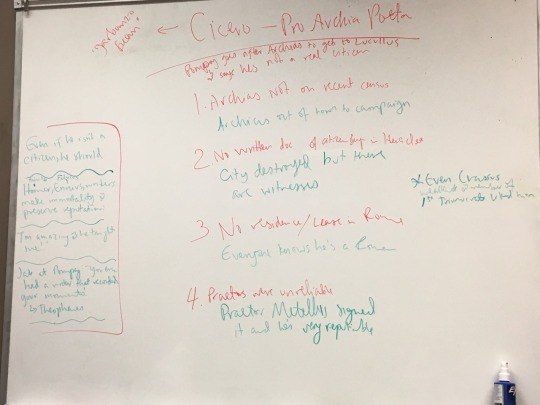this title is meant be read aloud, too. makes it more fun for those who overhear you.
Don't wanna be here? Send us removal request.
Text
I just had a flashback to 11th grade when I was wearing a pair of baggy brown bf pants with a tucked in shirt and a belt and it was a super cute outfit and the pair of pants had actually belonged to my grandmother who gave them to me and I felt so confident and this girl in my class goes out loud in front of everyone “Peyton what even are those pants” and I was like ummmm pants? And then she was like ok and then openly talked about how ugly they were and I just sat down and got super upset bc why was she judging me for what I wore? First of all I was wearing nothing out of the ordinary but also she only ever wore sweatshirts and leggings every day so I just bit my tongue and realized that she must have some major insecurities if she had to take me down in front of my entire chemistry class. I love clothes and trying new combinations of outfits and finding go-to looks for any occasion. Fashion is going to be a huge component of my career and I should never have let her upset me. People who have ambitions and want to try new things should never be discouraged by those who are stuck in their ways. I’m writing this to hopefully inspire those who feel trapped in high school or in their social circle, it’s never too late to change yourself and rebrand yourself to who you feel like you want to be. Don’t get stuck doing what everyone else is doing because you’re afraid to do things for you!! Mic drop
186 notes
·
View notes
Photo










Tweets from Parents that Perfectly Summed up Parenting
145K notes
·
View notes
Photo




Above: Honors Student Slips into Insanity | ca. 2016
6 notes
·
View notes
Photo

We track the progress of Aeneas by sticking a panda emoji on the map of the underworld 🐼 … our class is pure trash #sorrynotsorry
4 notes
·
View notes
Photo
Thank you for this kind review. The Minerva Medica is a building dedicated to the goddess Minerva. Like the Temple of Jupiter Optimus Maximus, the additional surname indicates the specifically venerated version or aspect of the goddess that the temple represents. A Nymphaeum honors nymphs, in this case water-spirits. This structure flanks the Sessorian palace complex and lies by the same gardens. A simple hypothesis suggests that it contributed to the building to which it is physically adjacent. Most significantly, the structure incorporates nature. The large and multitudinous windows beckon light and breeze. Leaves from the aforementioned garden fall inside it. This Roman building particularly attempts harmony with nature.
<3



Nymphaeum in the Horti Liciniani (Temple of Minerva Medica):
The Nymphaeum in Horti Liciniani, originionally called the Temple of Minerva Medica, boasts beautiful arches and domes, features that pervaded Roman architecture in the common era. The purpose of this structure is highly disputed. While it is no longer believed to represent the Minerva Medica, arguments against its function as a Nymphaeum exist, as well. One theory suggests that this structure contributed to a Sessorian palace complex (Campbell, 300-301). The rich detail on the outside and large dome hold significant grandeur, indicating that the building held a special purpose. The roof used to be a solid though unstable dome; multiple additions supported its weight (Campbell, 302). The squares impressed into the concrete dome add delicacy and depth to the dome, casting shadows that draw the eye. Unlike the Greek’ Sanctuary of Pan and its dedication to the nymphs, this monument located in Esquiline, Rome, Italy encloses the visitor. The large arches provide wide entrances, which compliment the theory that the structure honored the nymphs. The repeated round shapes lack harsh edges, and innovative angular columns helped to balance this organic flow with solid shapes that lend order and symmetry to the building. Additionally, opus testaceum composes this building, unlike the marble that encompassed Greek temples (Campbell 302). The decorations on the building consisted of granite, porphyry, and marble, thought they have been lost (Campbell, 306).
Biography:
Campbell, Ian. “THE ‘MINERVA MEDICA’ AND THE SCHOLA MEDICORUM: PIRRO LIGORIO AND ROMAN TOPONYMY.” Papers of the British School at Rome 79 (2011): 299-328. http://www.jstor.org/stable/41725309.
Nymphaeum in the Horti Liciniani (Temple of Minerva Medica). 320 CE. Artstor Digital Library SCALA, Florence/ Art Rescource, NY. http://mobile.artstor.org/mobileartstor/pages/fullimage.jsp?url=scala/archives/scala_0026220g_post.fpx?cell=1024,768&cvt=jpeg&applicationname=mobileartstor&user=%22%22&objid=SCALA_ARCHIVES_1039779362&pid=nymphaeum%20in%20the%20horti%20liciniani~all
Nymphaeum in the Horti Liciniani (Temple of Minerva Medica). Early 4thc. Artstor Digital Library, John Pinto Collection, Princeton University. http://mobile.artstor.org/mobileartstor/pages/fullimage.jsp?url=princeton/pinto/pinto_216522_as_8b_srgb.fpx?cell=1024,768&cvt=jpeg&applicationname=mobileartstor&user=%22%22&objid=APINTOIG_10313945825&pid=nymphaeum%20in%20the%20horti%20liciniani~all
Nymphaeum in the Horti Liciniani (Temple of Minerva Medica). Early 4thc. Artstor Digital Library, William L. MacDonald Collection, Princeton University. http://mobile.artstor.org/mobileartstor/pages/fullimage.jsp?url=princeton/mcdonald/macdonald_205046_as_8b_srgb.fpx?cell=1024,768&cvt=jpeg&applicationname=mobileartstor&user=
#mcp#material culture project#finished#response#medica minerva#nymphaeum#version#aspect#medica#minerva
2 notes
·
View notes
Text
What an excellent choice for your final MCP! This succinct analysis provided excellent context around which the statue was constructed. A few questions for your peer response:
How did those who restored the Arch of Septimius Severus* know how it used to look? Were there accounts or illustrations of the arch’s splendor that allowed for its restoration? Was its appearance preserved in another way?
In what style are the friezes and panels? In what way do they depict movement? In what way do they depict the time period in which they were carved?
*All I could think about was Snape’s “septum severus” spell in Harry Potter the whole time I read this. Love. Love you, this awesome MCP, and Harry Potter. <3
Arch of Septimius Severus

The Arch of Septimius Severus was erected in 203 C.E. in celebration of Roman emperor Septimius Severus’ return to his native city of Lepcis Magnus, Libya (a part of the Roman empire at the time). Upon first excavation, the arch was in ruins, but has since been rebuilt in limestone and marble. The arch served as the focal point of Lepcis, standing alone at the center of four pathways and lush greenery.

This quadrifrons arch was designed to be entered at all sides. Each edge is linked together with an engaged, patterned Corinthian column. Smaller Corinthian capitals form midway down each archway. Additionally, free-standing Corinthian columns frame the sides of each entrance. The columns all stand a few feet off the ground on engaged platforms, with additional cubic capitals on top. Atop each capital lies a triangular structure jutting out from the building.
Nearly every available surface of the arch is covered with some sort of sculpture. Victories line the areas next to the columns, figures make up the two architraves framing the empty frieze between the triangular figures, and the four attic friezes each contain a different scene in their reliefs.

One of the friezes portrays Severus’ family alongside divinities like Hercules and Fortuna, a clear display of respect and honor for the royal family.

Another frieze shows the chariot procession of Severus returning home to Lepcis. This event is what spurred the construction of the arch in the first place.

Within the monument, the underside of each archway is lined with a checkerboard pattern of cubes and figures, while the ceiling remains completely bare.
Bibliography:
Kleiner, Fred S. A History of Roman Art. Enhanced ed. Boston, MA: Wadsworth, 2010.
6 notes
·
View notes
Photo



Nymphaeum in the Horti Liciniani (Temple of Minerva Medica):
The Nymphaeum in Horti Liciniani, originionally called the Temple of Minerva Medica, boasts beautiful arches and domes, features that pervaded Roman architecture in the common era. The purpose of this structure is highly disputed. While it is no longer believed to represent the Minerva Medica, arguments against its function as a Nymphaeum exist, as well. One theory suggests that this structure contributed to a Sessorian palace complex (Campbell, 300-301). The rich detail on the outside and large dome hold significant grandeur, indicating that the building held a special purpose. The roof used to be a solid though unstable dome; multiple additions supported its weight (Campbell, 302). The squares impressed into the concrete dome add delicacy and depth to the dome, casting shadows that draw the eye. Unlike the Greek’ Sanctuary of Pan and its dedication to the nymphs, this monument located in Esquiline, Rome, Italy encloses the visitor. The large arches provide wide entrances, which compliment the theory that the structure honored the nymphs. The repeated round shapes lack harsh edges, and innovative angular columns helped to balance this organic flow with solid shapes that lend order and symmetry to the building. Additionally, opus testaceum composes this building, unlike the marble that encompassed Greek temples (Campbell 302). The decorations on the building consisted of granite, porphyry, and marble, thought they have been lost (Campbell, 306).
Biography:
Campbell, Ian. "THE 'MINERVA MEDICA' AND THE SCHOLA MEDICORUM: PIRRO LIGORIO AND ROMAN TOPONYMY." Papers of the British School at Rome 79 (2011): 299-328. http://www.jstor.org/stable/41725309.
Nymphaeum in the Horti Liciniani (Temple of Minerva Medica). 320 CE. Artstor Digital Library SCALA, Florence/ Art Rescource, NY. http://mobile.artstor.org/mobileartstor/pages/fullimage.jsp?url=scala/archives/scala_0026220g_post.fpx?cell=1024,768&cvt=jpeg&applicationname=mobileartstor&user=%22%22&objid=SCALA_ARCHIVES_1039779362&pid=nymphaeum%20in%20the%20horti%20liciniani~all
Nymphaeum in the Horti Liciniani (Temple of Minerva Medica). Early 4thc. Artstor Digital Library, John Pinto Collection, Princeton University. http://mobile.artstor.org/mobileartstor/pages/fullimage.jsp?url=princeton/pinto/pinto_216522_as_8b_srgb.fpx?cell=1024,768&cvt=jpeg&applicationname=mobileartstor&user=%22%22&objid=APINTOIG_10313945825&pid=nymphaeum%20in%20the%20horti%20liciniani~all
Nymphaeum in the Horti Liciniani (Temple of Minerva Medica). Early 4thc. Artstor Digital Library, William L. MacDonald Collection, Princeton University. http://mobile.artstor.org/mobileartstor/pages/fullimage.jsp?url=princeton/mcdonald/macdonald_205046_as_8b_srgb.fpx?cell=1024,768&cvt=jpeg&applicationname=mobileartstor&user=
2 notes
·
View notes
Text
Comment:
I am so thankful that the Romans finally got into the whole theater thing. They held such global influence that had they not preserved and recognized the value in such a spectacular art form. Did they revitalize theater to distract their citizens or for their own enjoyment?
0 notes
Text
Question:
Why did the Romans separate their audience from the rest of the world when performing plays? Did they mean to promote immersion and escapism? This separation is common in modern-day movie theaters– did we get this idea from the Romans?

1 note
·
View note
Text
Formal Parthenon Reflection:
At the Nashville Parthenon on September 29th, I attended the first of a two-part lecture series. Listening to a lecture inside a full-sized replica of the Athenian Parthenon made focus quite difficult, but Joseph Rife’s fascinating account resulted in three pages of notes on the last blank pages of my copy of Philoctetes.

The lecturer discussed his archeological excursion to “Roman Kempiai” (or Campreaí). His lecture centered around the religious implications of artifacts discovered around this coastal town; a Greek cup; Christian lamp; statues of three deities that protected the town’s harbor; lead tablets in cemeteries laden with curses meant for the living; a two-sided ring; and the Octagon. The ring in particular drew my attention. Made of blue glass, the ring’s opposite sides depicted the goddess Aphrodite and god Osiris. I asked the lecturer which side would have faced outward. He suspects that Aphrodite decorates the inside of the ring and Osiris the outer. I asked about the significance of this placement, and we speculated a bit. Unfortunately, Dr. Rife remarked, no concrete evidence indicates the use of this beautiful artifact, so speculation is the most his archeology team can do.

After surmising the religions indicated by the artifacts, he concluded that traditional Greek, Roman, Egyptian, and Christian beliefs thrived in this region, as well as the practice of magic. To have so many religions saturate one area reminds me of how small the world is. Movements overflow their regional cups and spill onto others to stain the soil in new places daily.

The Parthenon embodies this phenomenon. I recognize the privilege of experiencing both the lecture and its setting.

#parthenon#parthenon reflection#athenian parthenon#nashville#lecture#ariel#lions#fun#rings#blue glass#osiris#aphrodite#jesus#egypt#christian#magic#isis#joseph rife
1 note
·
View note
Text
Question:
Hello!
So, guess who accidentally read and wrote comments/questions about books 2 AND 3 over the weekend... *points to self* this girl! It’s all okay though, because Augustine has a lot to say, so there was plenty I didn’t cover ;).
Okay! Let’s talk about Augustine’s mum.

Obviously, Augustus isn’t Rapunzel, and his mother was no queen, but they seem very close. What was her role in the family household? I know that patriarchy was a real thing, but Christianity shook things up (at least for a little while), right? How was her relationship with her husband? Were they close? From Augustine’s dislike of his father and love for his mother, it seems that they were very different. Monica tried to convert her son; would she have tried to convert her husband, too? Also, was the bishop really prophesying, or just trying to get her to be quiet and stop bothering him? It reminds me of the Bible story about the woman and the corrupt judge. She bugged him to settle her case so persistently that he finally did, just to get her off his back.
Perseverance is a beautiful. Pestering can have its benefits, too. :)
0 notes
Text
Comment:
Hello!
So, guess who accidentally read and wrote comments/questions about books 2 AND 3 over the weekend... *points to self* this girl! It’s all okay though, because Augustine has a lot to say, so there was plenty I didn’t cover ;).
I found it very interesting how Augustus’ view on child-likeness changes as he grows older and reads the Scriptures. At the beginning, he defends it from school-work, over-discipline, and the modern constructs in the education youngsters, but he admits that before his spiritual... let’s call it enlightenment, he felt he was “above such childishness.” This childishness was in fact humility and consideration of the Scriptures. How interesting that childlike tendencies come into importance through his salvation. Just thought that it was worth pointing out :).

1 note
·
View note
Text
Question:
Augustine makes a lot of claims about God that are kinda foreign to me. He says that God doesn’t approve of sex unless it is specifically an attempt to make children? What? And he says that God can’t suffer unhappiness? I had never heard that before this. Didn’t Augustine assert that his sin grieved God? Were these commonly held theological stances in Christianity at this time, or were these personal beliefs held by the man writing these Confessions? Did others define evil as the lack of good, as well?
0 notes
Text
Comment:
St. Augustine’s reflection on robbery in “Pear Theft” made me think of Oceans 11 for some reason. He talked about robbery not having the “maimed and shadowy beauty that other sins pretend to,” but I disagree. Think of all the movies about spies who steal key evidence to save their countries, or a gang of criminals pulling a heist to pad their own wallets. Something thrilling, the magic of a perfect slight of hand, misdirect, etc., makes these things beautiful. It’s a trick, and we all want in on the secret. Thievery has an adrenaline rush associated with it, yes, but these movies don’t become classics because of adrenaline. They are successful because the heroes (I use the word loosely) are clever enough to get away with their crime. They break the rules and live to sin another day. They seem somehow above it all. I think that is part of the draw; to prove that one is extraordinary.

1 note
·
View note











